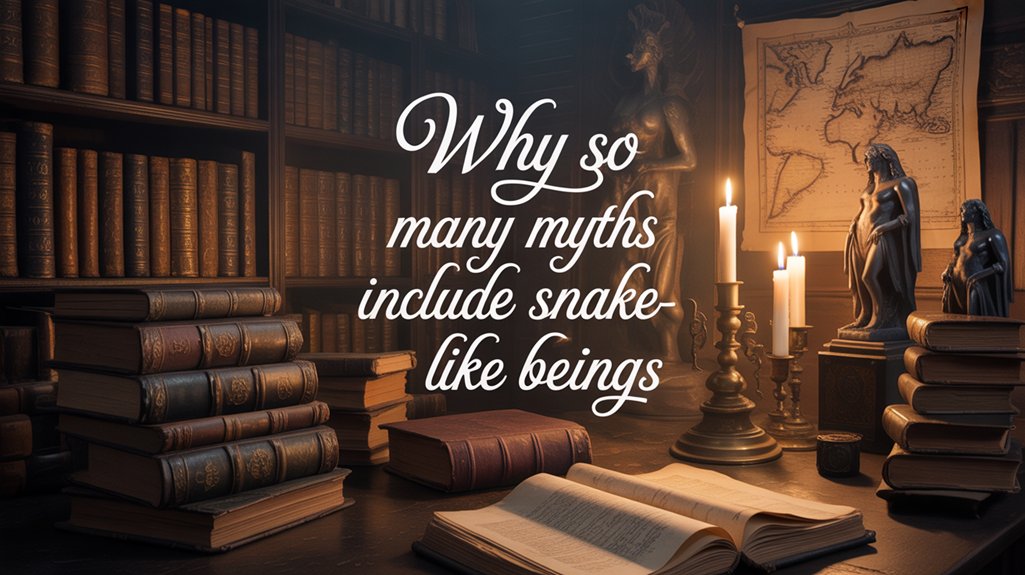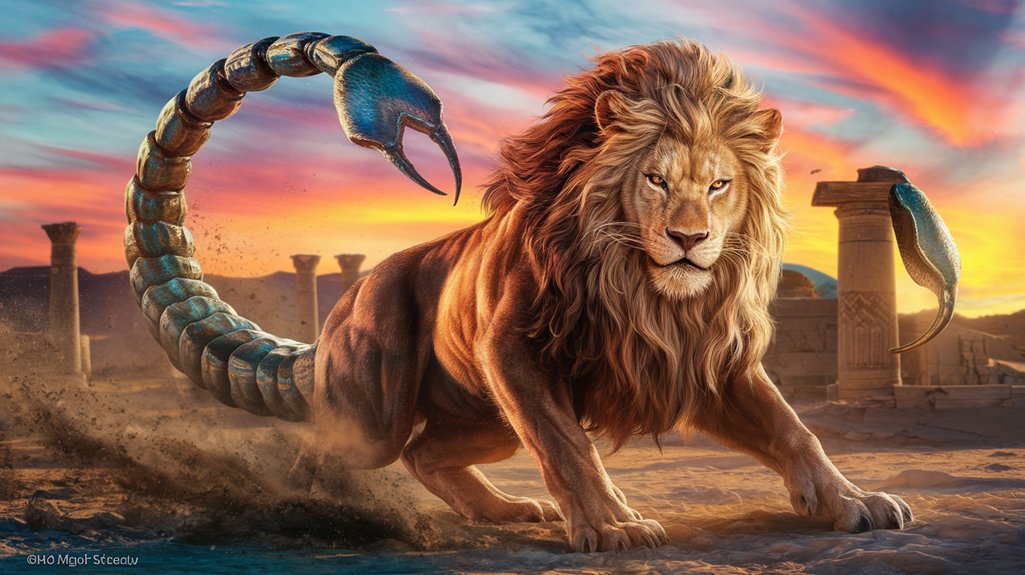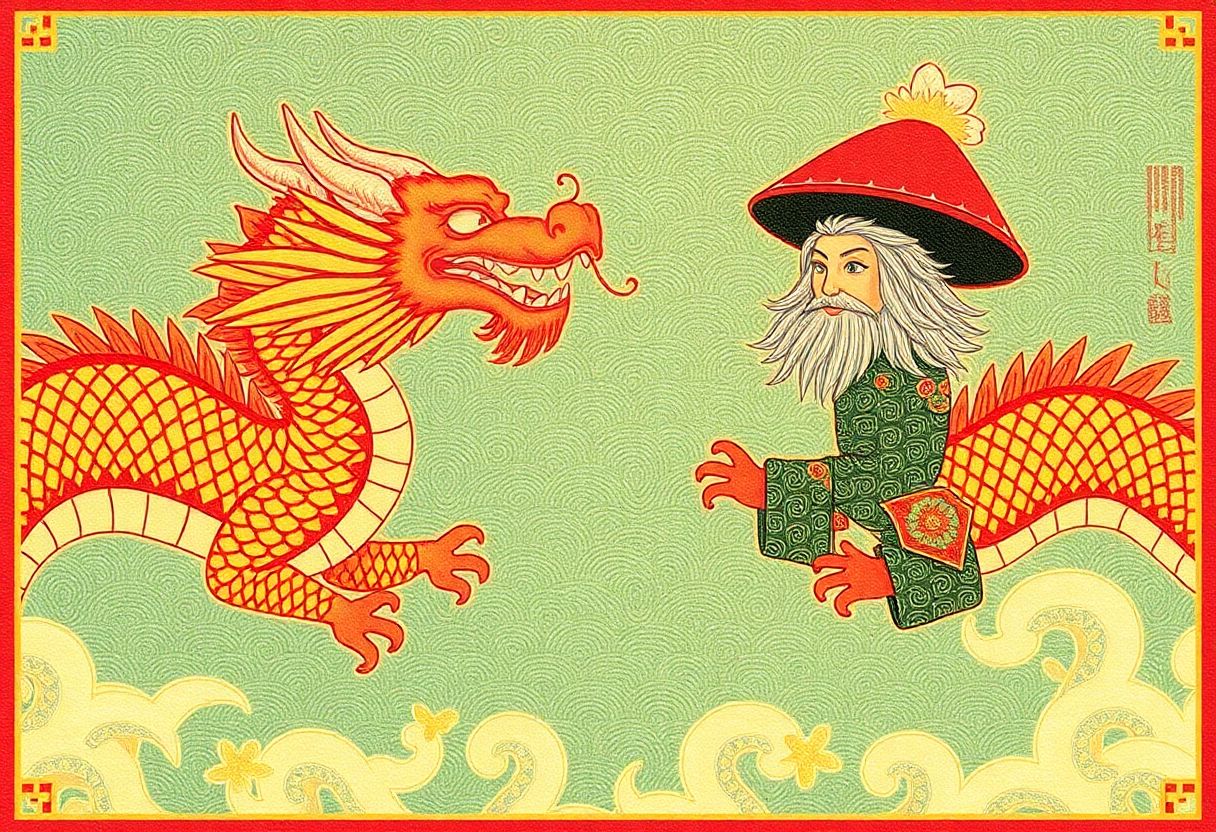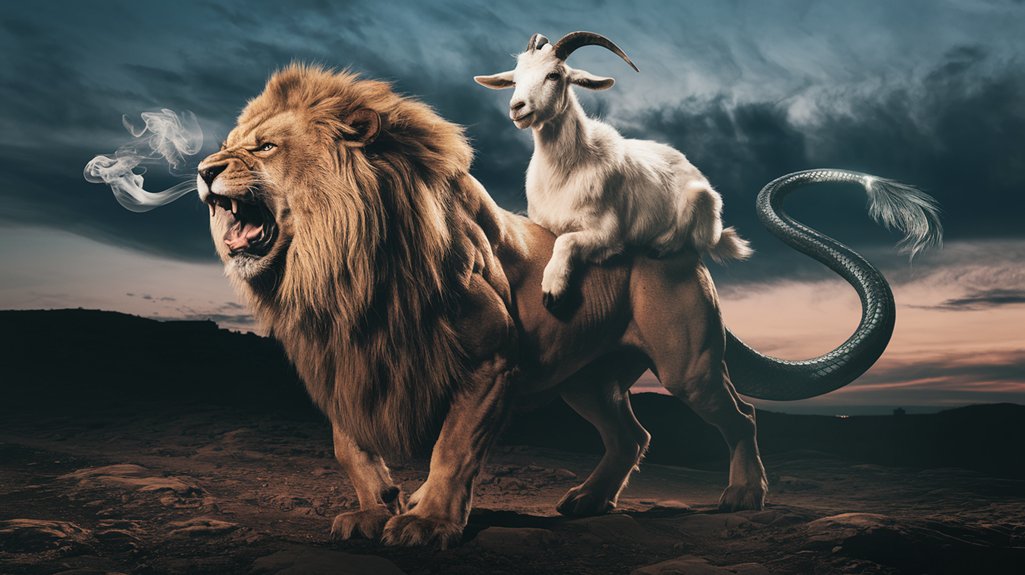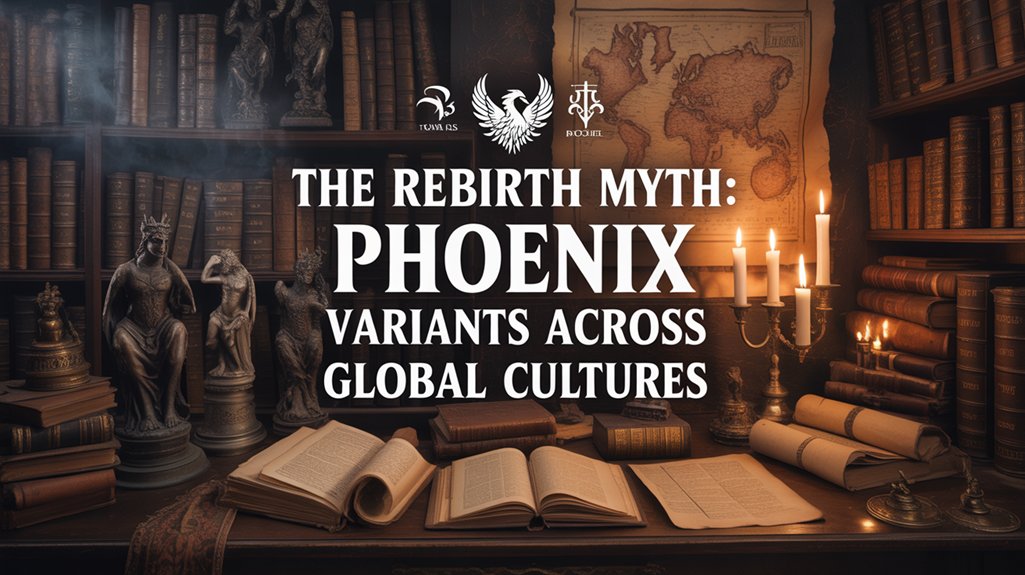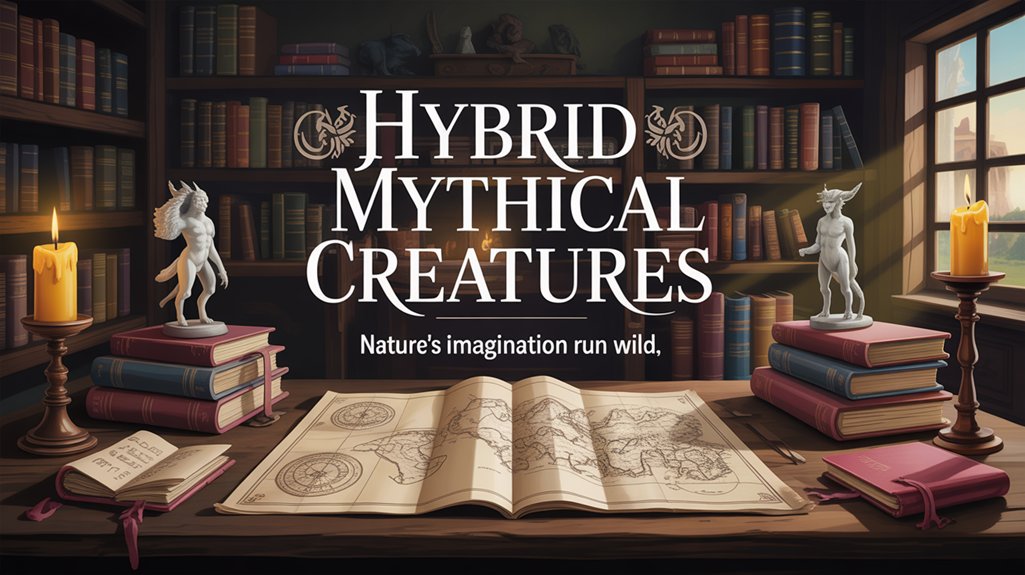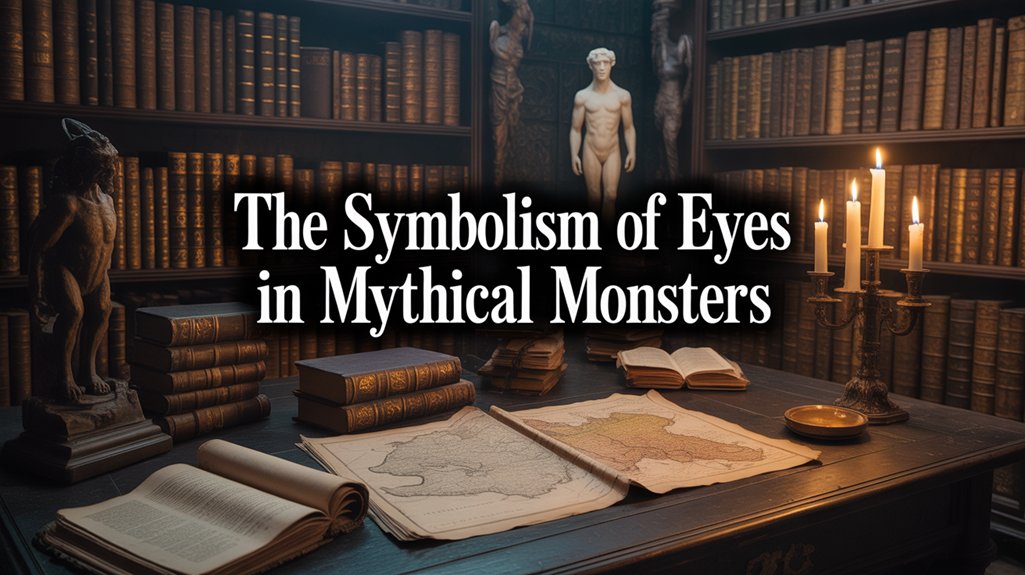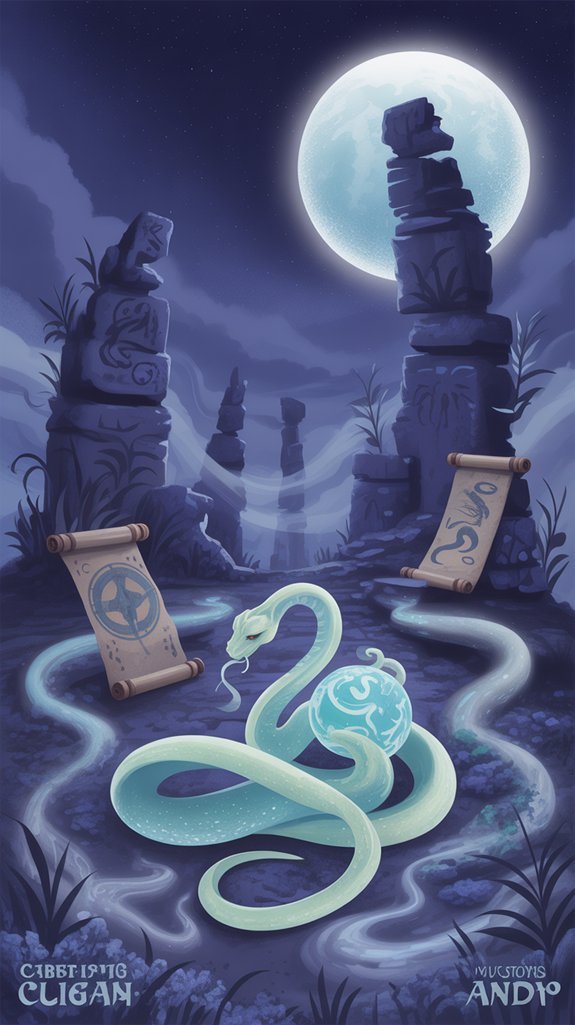
Your brain inherited serpentine dread from primate ancestors—neurons recognizing scaled forms faster than any stimulus, altering evolutionary vigilance into mythological architecture. From Mesopotamia’s chaos-serpent Tiamat to Australia’s Rainbow Serpent carving waterways, these limbless predators embodied alteration’s essence: shedding skin symbolized rebirth, venom promised both death and healing, while their threshold-dwelling nature between earth and water mirrored humanity’s own liminal existence between order and chaos. What neuroscience reveals as hardwired fear, your ancestors transmuted into sacred narratives encoding survival wisdom—and beneath these ancient patterns lie deeper revelations about consciousness itself.
Table of Contents
ToggleKey Takeaways
- Human brains evolved specialized neural circuits that detect serpentine shapes faster than other stimuli, reflecting ancient survival instincts against venomous snakes.
- Serpents symbolize fundamental dualities across cultures: creation and destruction, wisdom and corruption, healing and death, embodying life’s essential ambiguities.
- Infants show innate fear responses to snake forms, indicating biologically inherited vigilance rather than purely learned behavior from cultural conditioning.
- Serpents’ physical transformation through skin-shedding made them powerful metaphors for renewal, metamorphosis, and the cyclical nature of existence and death.
- Ancient encounters with dangerous snakes created primal terror that cultures transformed into mythological narratives around chaos, power, and cosmic order.
Serpents Slither Through Human Mythology
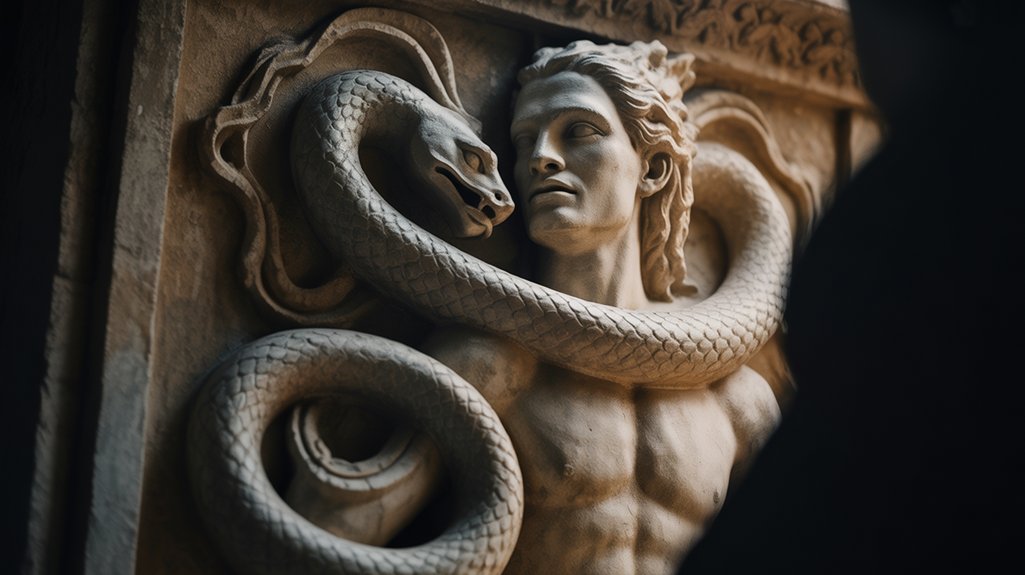
Though serpents possess neither limbs nor voice, they’ve coiled themselves around humanity’s collective unconscious with a grip that spans millennia. From the Nile Delta to Aboriginal Dreamtime, mythical serpents emerged as chimeric embodiments of humanity’s deepest fears and highest aspirations.
You’ll find them everywhere—lurking in creation myths, slithering through apocalyptic visions, coiling around cosmic axes.
The Egyptian Apophis devoured sunlight itself. Greece’s Python guarded eldritch knowledge at Delphi’s omphalos. The Rainbow Serpent carved Australia’s waterways during the Dreaming. These weren’t mere cautionary tales. They represented something profound: metamorphosis’s terrible price.
Cultural interpretations varied dramatically—serpents could herald destruction or renewal, sometimes simultaneously. Their biological reality—the silent strike, the paralyzing venom, the hypnotic undulation—provided perfect metaphorical material.
Ancient peoples recognized in serpents a creature perpetually reborn through skin-shedding, existing in liminal spaces between earth and water, life and death. Pure archetypal power.
##
You stand at the threshold where serpentine forms coil through humanity’s deepest symbolic architectures, their scaled bodies bearing meanings that shift between veneration and revulsion, between the eldritch power of creation and the chimeric threat of annihilation.
These ophidian figures emerge from evolutionary memory itself—that primal recognition of sinuous movement in tall grass, now transformed into deities, demons, and world-shapers across continents separated by vast oceans yet united in their serpentine visions.
The duality persists: snakes as both cosmic architects weaving reality from chaos and cunning tempters whose forked tongues promise forbidden wisdom at civilization’s trembling margins.
This recurring motif represents humanity’s common quest for understanding the fundamental tensions between order and disorder that define existence across all cultures.
Ancient Symbolism and Duality
Since the earliest civilizations etched their cosmologies into clay and stone, serpentine forms have coiled through humanity’s sacred narratives as manifestations of paradox itself—creatures that embody both veneration and terror, creation and annihilation, the healer’s staff and the assassin’s strike.
You’ll find this duality symbolism woven throughout Mesopotamian creation epics, where Tiamat’s serpentine chaos births cosmic order through her violent death. The Egyptians recognized snake wisdom in the uraeus adorning pharaonic crowns—protective yet lethal.
Ancient Greece’s Asclepius wielded the serpent as emblem of pharmaceutical knowledge, while Python represented eldritch corruption Apollo must destroy.
This chimeric nature persists: guardian and transgressor, earthbound and transcendent. The Greek bestiary cataloged numerous serpentine monsters and fabulous creatures that inhabited the boundary between divine and mortal realms. The snake defies categorization, demanding you acknowledge life’s fundamental ambiguity—that alteration requires destruction, that knowledge carries venom.
Fear Embedded in Evolution
Before consciousness could name the danger, your ancestors’ neurons fired recognition—a particular S-curve slicing through savanna grass, that telltale undulation triggering cascades of cortisol and adrenaline that meant survival.
This hardwired vigilance, etched into your limbic system across millennia, explains why evolutionary psychology reveals your brain processes serpentine shapes faster than any other stimulus. Ancient. Automatic. Inescapable.
Your inherited dread became bedrock for cultural narratives spanning continents—the eldritch serpent guarding forbidden knowledge, the chimeric dragon demanding sacrifice.
When early humans gathered around fires, they wove this primal terror into meaning, altering biological imperative into mythological truth.
You carry that same neural architecture today, responding to shadows that coil and twist, your autonomy momentarily surrendered to evolutionary wisdom that once meant the difference between bloodline continuation and extinction.
Creation Stories Across Cultures
From that genetic inheritance emerged something more elaborate, more architecturally ambitious—your ancestors altered raw fear into cosmogonic narrative, elevating the serpent from mere predator to primordial architect.
Cultural interpretations across civilizations positioned these eldritch entities as chaos personified: Egypt’s Apep writhing against Ra’s solar order, Mesopotamia’s chimeric Tiamat fragmenting into earth and sky, the Aboriginal Rainbow Serpent carving waterways through dreamtime’s membrane.
Serpentine symbolism embodied the fundamental paradox—destruction preceding genesis, venom changing into medicine. The Genesis serpent offered forbidden gnosis, transformative corruption.
These weren’t simple monster tales but philosophical codices exploring humanity’s precarious position between wilderness and civilization. You inherited narratives where serpents guarded thresholds, where their undulating forms traced the boundary between what was and what could be, between primordial chaos and ordered cosmos.
Power and Transformation Themes
Though physical metamorphosis marks the serpent’s most visible attribute—that methodical sloughing of old integument revealing pristine scales beneath—the true potency resided in what that alteration *represented* to your forbears: power’s fluid nature, identity’s malleability, death’s negotiable terms.
You witness mythical power encoded in every serpentine guardian coiled around sacred trees, each monster slain by heroes undertaking *transformative* journeys from fragility to sovereignty.
The duality persists—venom that kills, venom that heals—reflecting authority’s chimeric essence. Ancient peoples recognized this: the ouroboros consuming itself eternally, Asclepius’s rod entwined with healing serpents, Quetzalcoatl’s feathered scales merging earth and sky.
These weren’t mere symbols but eldritch truths about existence itself. Power *transmutes*. Wisdom destroys ignorance. Death births renewal. The serpent simply *was* these paradoxes incarnate.
Mesopotamian Creation Myths, 4000 BCE

In the primordial depths of Mesopotamian cosmology, you encounter Tiamat, the eldritch dragon-goddess whose serpentine form coiled through the salt waters of creation itself, embodying the churning chaos that preceded all ordered existence.
She emerged from the ancient Tigris-Euphrates River Valley’s mythic imagination around 4000 BCE, her monstrous essence recorded in cuneiform tablets that still whisper of her terrible majesty.
Before Marduk’s storm winds tore her body asunder to forge the heavens and earth, Tiamat reigned as the ultimate chimeric mother—both womb and tomb, nurturing the first gods while threatening to devour the cosmos entire.
Tiamat the Primordial Dragon-Goddess
Chaos churned in the primordial waters of the Abzu before human memory could record it, and there Tiamat reigned—not as mere monster, but as the embodiment of the salty deep itself, her serpentine coils encompassing the totality of unmade potential.
Tiamat’s symbolism transcends simple villainy; she represents the necessary destruction that precedes creation, the fertile chaos from which all order must emerge.
When Marduk split her massive body to forge heaven and earth, you’re witnessing humanity’s earliest recorded attempt to understand existence itself.
Tiamat’s offspring—eldritch beings both divine and chimeric—populated the cosmos before order imposed its will.
Her 4000 BCE narrative reminds you that freedom requires engaging with chaos, that civilization’s structures rest upon foundations deliberately carved from the wild, untamed deep.
Ancient Tigris-Euphrates River Valley
Between the twin arteries of the Tigris and Euphrates, where silt-laden waters deposited the very substance of civilization, Mesopotamian scribes pressed wedge-shaped marks into clay tablets—preserving cosmogonies that positioned serpentine entities at the threshold between void and cosmos. These ancient rivers carved mythic landscapes where chimeric beings embodied primordial disorder, awaiting conquest by hero-gods who’d establish civilization’s bedrock.
| Serpent Entity | Symbolic Function | Cultural Significance |
|---|---|---|
| Tiamat | Saltwater chaos personified | Defeated by Marduk; order emerges |
| Guardian serpents | Protectors of sacred treasures | Dual nature: threat and shield |
| Fertility serpents | Water-bringers, life-givers | Cyclical creation and destruction |
You’ll find in these narratives an eldritch pattern: serpents guarding thresholds, embodying the dangerous passage from formlessness to structured existence. The Enuma Elish crystallizes this struggle—humanity defining itself against chaos incarnate.
Represented Chaos and Salt Water
When Marduk raised his storm-winds against the primordial deep, he confronted not merely a goddess but the chaotic essence of saltwater itself—Tiamat, whose serpentine coils embodied the undifferentiated abyss preceding all structure.
You’ll find in these Mesopotamian texts—dating to 4000 BCE—the quintessential chaos representation: a chimeric dragon-serpent whose very existence threatened cosmic order. Her body was the primordial waters, that eldritch ocean stretching beyond human comprehension, salt-bitter and formless.
Marduk’s victory wasn’t simple conquest. It was metamorphosis. He split her corpse, fashioning heaven from her skull, earth from her lower half.
Here lies the pattern you’ll recognize across countless traditions: the serpent must be defeated, dismembered, reorganized. Order demands it. Creation requires the sacrifice of chaos itself.
Greek Serpent-Haired Gorgon Medusa
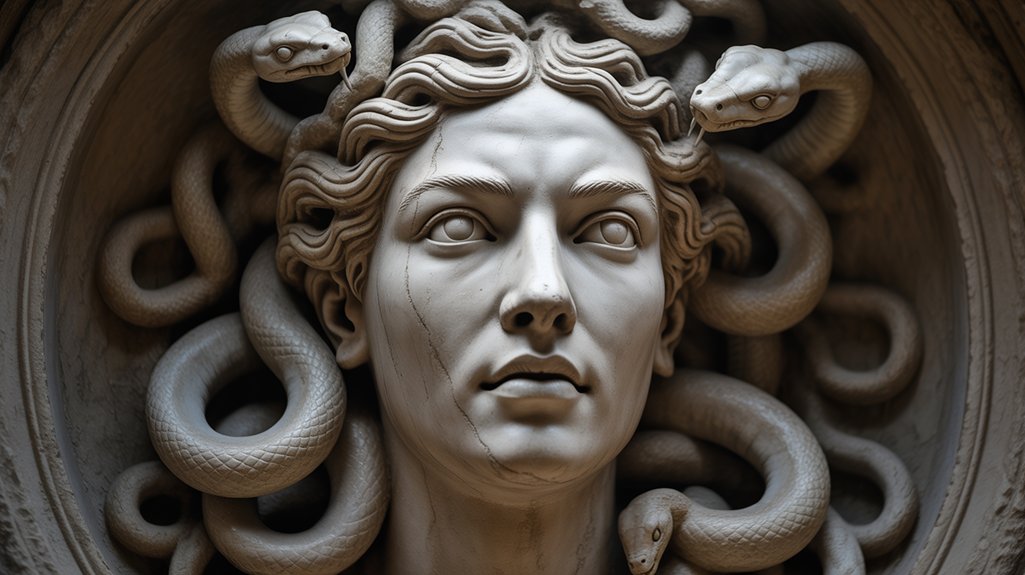
Among the pantheon of Greek mythological terrors, none provokes such visceral fascination as Medusa—the serpent-crowned Gorgon whose petrifying gaze altered living flesh into cold stone.
Medusa’s alteration unfolded through tragedy: once a ravishing maiden, she suffered Poseidon’s violation within Athena’s sacred precinct, whereupon the goddess cursed her with writhing serpents replacing golden tresses. This metamorphosis embodied victimization’s cruel paradox—punished for desecration she didn’t instigate.
| Symbolic Aspect | Cultural Function | Mythic Significance |
|---|---|---|
| Serpentine Crown | Eldritch alteration | Beauty corrupted into monstrosity |
| Petrifying Gaze | Apotropaic protection | Weaponized feminine power |
| Shield Iconography | Ward against malevolence | Guardian totem |
| Perseus’s Beheading | Heroic conquest | Masculine dominance reasserted |
Gorgon symbolism transcended simple monstrosity. Her visage adorned warriors’ shields, altering victim into protector. Perseus’s reflective stratagem—avoiding direct confrontation—revealed deeper truths about confronting eldritch dangers. From her severed neck sprang Pegasus, the winged stallion: death birthing transcendence. Medusa remains chimeric—simultaneously victim and threat, beautiful and monstrous, destroyed yet eternally powerful.
Snakes as Transformation Symbols
Throughout humanity’s mythological consciousness, serpentine entities embody metamorphosis’s most potent archetype—their cyclical skin-shedding enacting death’s temporary nature and rebirth’s eternal promise.
You’ll discover snake shedding operates as primal metaphor across civilizations, revealing mythological parallels that transcend geographic boundaries:
- Asclepius’s caduceus (ancient Greece, circa 300 BCE) merged serpentine wisdom with medical arts, where venom’s dual capacity—destroyer and healer—embodied alteration’s paradox.
- Genesis’s Eden serpent catalyzed humanity’s metamorphosis from prelapsarian innocence into knowledge’s burden, initiating moral consciousness through transgression.
- Quetzalcoatl’s chimeric form (Mesoamerica, 100 CE onwards) synthesized earthbound reptile with celestial plumage, manifesting liminal space between mortal and divine.
These eldritch beings challenge you to confront metamorphosis as sacred ordeal. When heroes encounter serpentine guardians, they’re facing alteration’s price—the death of former selves, the shedding of comfortable illusions.
Confronting the serpent means accepting transformation’s cost: surrendering who you were to become who you must be.
The snake doesn’t merely symbolize change. It demands it.
Garden of Eden Serpent
You’ll find the Garden of Eden serpent occupying a liminal threshold between primordial wisdom and eldritch corruption. Its crafty presence in Genesis 3:1 represents far more than simple temptation—it embodies the ancient Near Eastern archetype of the chaos-serpent, altered through Hebrew theology into humanity’s archetypal deceiver.
This chimeric figure, simultaneously beautiful and malevolent, introduces doubt into sacred space through its whispered rebellion against divine command, establishing an eternal enmity between serpentine cunning and human redemption (Genesis 3:14-15).
The creature’s alteration from upright being to belly-crawler marks a cosmological shift, a cursed metamorphosis that shadows every subsequent encounter between humanity and the snake-form’s seductive, transformative power.
Biblical Symbolism and Temptation
Within the primordial narrative of Genesis, composed during the Babylonian exile circa 6th century BCE, the serpent emerges as an eldritch figure—neither wholly beast nor demon, but something liminal that speaks with honeyed words and promises divine knowledge.
You’ll find biblical temptation manifests through this creature’s calculated subversion of divine order, its questions designed to fracture Eve’s resolve. The serpent symbolism operates on multiple registers: cunning adversary, embodiment of spiritual rebellion, Satan’s earthly mask.
When God curses it to crawl belly-down through dust, you’re witnessing consequence made flesh. Yet Genesis 3:15 offers something radical—a cryptic promise that Eve’s descendant will crush the serpent’s skull.
This prophecy births Christianity’s redemptive arc, altering defeat into hope.
Ancient Near Eastern Context
When Bronze Age scribes shaped the Eden narrative, they weren’t creating in a vacuum—they drew from a churning wellspring of Mesopotamian cosmology where serpents had already prowled for millennia.
You’ll find serpent symbolism threading through Sumerian hymns and Babylonian epics, where these eldritch creatures embodied both cunning wisdom and primordial terror. The Genesis serpent’s craftiness echoes older patterns of chaos representation—those chimeric adversaries who challenged divine order in Enki’s temples and Marduk’s triumph songs.
Notice how the curse alters magnificent creature into belly-crawler, humiliating chaos itself. This wasn’t merely punishment. It was cosmic reordering. The promised enmity between serpent and humanity becomes your inheritance, a battle against entropy that ancient scribes recognized as humanity’s perpetual struggle toward liberation from primeval darkness.
Serpent’s Transformative Role
Though catalogued as mere reptile in modern taxonomies, the Genesis serpent operates as something far more sinister—a liminal entity whose very presence fractures the boundary between creature and cosmic force.
You’re witnessing serpent symbolism at its most eldritch inception: the creature doesn’t simply tempt Eve, it fundamentally changes humanity’s existential trajectory. This isn’t passive observation. The serpent catalyzes awareness itself, forcing recognition of moral dimensions previously hidden from human consciousness.
Transformative narratives across Mesopotamian, Egyptian, and Canaanite traditions echo this pattern—chimeric beings initiating humanity into forbidden knowledge, beauty masking devastation.
Yet Genesis 3:15 disrupts the cycle, promising enmity that foreshadows redemption. Here lies the paradox: the serpent’s deception simultaneously damns and awakens, creating the very conditions necessitating salvation. Chaos births hope.
Harry Potter’s Basilisk Monster
In J.K. Rowling’s universe, the Basilisk emerges as a chimeric symbol to enduring serpent mythology, its eldritch nature rooted in medieval European folklore. This creature—hatched from a cock’s egg beneath a toad—embodies Basilisk mythology’s darkest iterations, wielding death through its gaze alone.
Within *Chamber of Secrets*, Tom Riddle weaponizes this ancient horror, altering Hogwarts into a hunting ground where petrified victims bear witness to serpentine malevolence.
The Harry Potter symbolism resonates deeply:
- The killing gaze represents knowledge that destroys innocence, vision corrupted into weaponized perception.
- Parseltongue command links linguistic power to ancestral darkness, heritage weaponized.
- Sword of Gryffindor’s victory demonstrates courage transcending inherited evil.
The creature’s defeat through Gryffindor’s blade—saturated with Basilisk venom itself—creates a paradox: poison becoming antidote, darkness consuming darkness.
This narrative thread weaves contemporary fantasy into humanity’s oldest fears, where serpents embody change’s most terrifying potential. The monster dwells in liminal darkness, waiting.
Innate Fear Response Research
Beyond the literary manifestations of serpent dread lies something more primal—a recognition etched into neural pathways before language, before culture, before conscious memory.
Neuroscientists have mapped this innate fear through rigorous experimentation, discovering that human infants, untouched by cultural conditioning, display heightened responses to ophidian forms. Your brain processes serpentine imagery through specialized circuits, responding milliseconds faster than to benign stimuli—an evolutionary survival mechanism forged across millennia when your ancestors who feared these eldritch creatures lived while others perished.
The evidence proves undeniable. Phobic responses traced to childhood experiences merely amplify what already exists within you, biological inheritance manifesting as psychological reality.
This collective consciousness spanning continents, preserved in chimeric myths from Mesopotamian tablets to Mesoamerican codices, reflects not superstition but survival wisdom encoded genetically.
Your serpent fear transcends learning. It breathes within synapses, an ancient warning system protecting descendants of those who recognized danger coiled in grass, hidden beneath stone.
Snake Conservation Efforts Worldwide
While your neural architecture maintains its ancient vigil against serpentine threats, a paradoxical revolution unfolds across continents—conservationists labor to preserve the very creatures your DNA commands you to fear.
Conservation initiatives now stretch across ecosystems where ophidian forms slither through diminishing territories, their presence essential to ecological equilibrium. The IUCN catalogs endangered species with scholarly precision, identifying which serpents require immediate intervention. Habitat preservation efforts protect these eldritch domains where snakes maintain their primordial roles as predator and prey.
Ancient predators fade from their ancestral domains while conservationists race to protect ecosystems that depend on their serpentine presence.
Education programs convert ancient dread into understanding. Community-driven citizen science projects monitor populations, changing fear into stewardship. Laws emerge protecting species once vilified in chimeric mythologies, recognizing their ecological significance beyond symbolic terror.
Your ancestors encoded serpentine wariness into your amygdala; you now possess the knowledge to transcend that inheritance. The snake, simultaneously threatening and threatened, demands your attention not through instinctual alarm but through conscious choice—preservation of biodiversity requires confronting the very fears evolution installed within you.
Separating Serpent Myth From Reality
Though serpent deities coil through humanity’s oldest narratives—from Mesopotamian Tiamat to Mesoamerican Quetzalcoatl—the creatures inspiring these mythologies possess none of the supernatural attributes their legends suggest.
You’ll find that serpent symbolism emerged from primal encounters, your ancestors’ neural pathways hardwired through millennia of avoiding venomous strikes. These mythological creatures represent chimeric projections of evolutionary fear, not eldritch truth.
Real serpents strike defensively, not maliciously. Their behavior spawned misconceptions about deception, altering ecological necessity into supernatural malevolence. You’re witnessing mesopredators maintaining biodiversity, not cosmic adversaries threatening existence.
The hero-versus-serpent archetype reflects your species’ survival narrative, nothing more. When you strip away the numinous layers—the alteration symbolism, the wisdom attributions, the good-versus-evil framework—you discover organisms fulfilling essential ecological functions.
Understanding this liberates you from inherited superstitions, revealing snakes as neither demons nor deities but crucial components of functioning ecosystems deserving protection, not persecution.
Frequently Asked Questions
Do All Cultures View Snake Mythological Beings as Evil or Dangerous?
No, you’ll discover serpentine deities transcend simple moral symbolism across cultural interpretations.
Ancient Egypt revered the cobra goddess Wadjet as royal protector, while Mesoamerican Quetzalcoatl embodied wisdom and creation itself.
Hindu traditions honor Nagas as guardians of sacred waters and treasures.
These eldritch beings aren’t universally malevolent—they’re liminal creatures dwelling between worlds, representing change, fertility, and cosmic power.
Your Western association with danger stems primarily from Abrahamic traditions, not universal human experience with these chimeric entities.
What Psychological Factors Make Snakes Compelling Symbols Across Different Civilizations?
You’re drawn to serpents because they embody primal psychological archetypes dwelling in your ancestral memory—the limbic brain’s ancient terror, alteration through shed skin, the chimeric fusion of earth and movement.
Their cultural symbolism transcends rational thought. Silent. Deadly. Eternal. They slither through your collective unconscious, triggering innate fear responses evolved over millennia.
You recognize in their coiled forms the eldritch power of regeneration, the duality of healing and venom, death and rebirth intertwined—symbols that liberate you from binary thinking.
Are There Common Physical Traits Shared by Snake Beings in Myths?
You’ll discover remarkable consistency in serpent symbolism across civilizations: elongated, sinuous forms; scales reflecting light like ancient armor; often chimeric fusions—human torsos merging with coiled tails.
Cultural variations emerge in details. Mesoamerican Quetzalcoatl bears feathered plumage. Nāga entities of Vedic India, dating to 1500 BCE, possess multiple cobra hoods.
Yet the essential morphology persists—limbless, undulating bodies that move through eldritch pathways between earth and water, embodying metamorphosis’s physical manifestation in serpentine flesh.
How Do Modern Snake Myths Differ From Ancient Cultural Representations?
You’ll find modern interpretations have stripped away the serpent’s sacred duality—that eldritch balance between creation and destruction your ancestors revered.
Today’s snake beings appear as monsters, aliens, or psychological archetypes divorced from ancient symbolism’s deeper resonance.
The chimeric Nagas of Angkor, Egypt’s cobra-crowned Wadjet, Mesoamerica’s Quetzalcoatl—these weren’t mere villains but threshold guardians embodying metamorphosis itself.
Contemporary narratives flatten this complexity, favoring simplistic good-versus-evil frameworks that deny you access to wisdom encoded in serpentine forms across millennia.
Why Are Female Snake Deities Less Common Than Male Ones?
You’ll find female representation in serpent mythology more abundant than patriarchal scholarship admits.
Ancient civilizations—Minoan Crete, pre-Vedic India, Mesopotamian temples—revered snake goddesses as primordial creators.
Cultural significance shifted when Indo-European invasions (circa 2000 BCE) systematically demonized these chthonic feminine powers.
The eldritch Tiamat, split by Marduk’s sword. Medusa, beheaded.
You’re witnessing deliberate erasure, not natural scarcity.
Snake women threatened emerging patriarchies. Their alteration, regeneration, earth-knowledge—too potent. Too free.
Conclusion
You’ve witnessed serpents slither through sacred stories, spanning Sumerian scriptures to Slytherin’s heir. These sinuous symbols—simultaneously sacred and sinister—mirror mankind’s most mysterious memories. Whether you’re confronting chimeric creatures in classical chronicles or examining eldritch echoes in Eden’s exile, you’ll discover serpentine forms forever coiled within consciousness itself. The snake’s persistent presence proves powerful: part primal programming, part profound archetype. You stand now between myth and meaning, where ancient wisdom whispers through scaled skin and forked tongues still speak truths you’re only beginning to decode.

